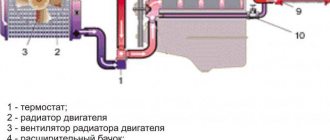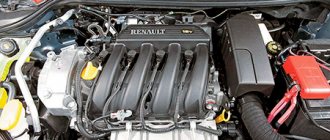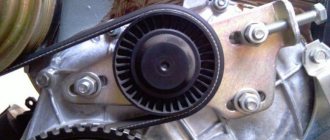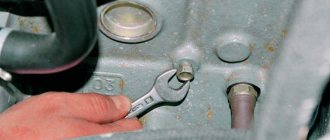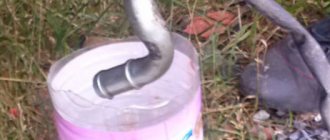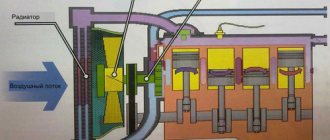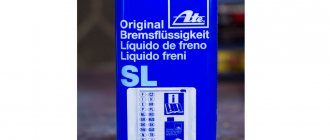Most car enthusiasts do not take the liquid poured into the car radiator seriously. But this is not just water, it has technical characteristics. For example, the density of antifreeze can tell about its quality and ability to perform its task.
To begin with, let’s resolve the well-known debate: “antifreeze or antifreeze?” In fact, this is nothing more than a play on words. The concept of “antifreeze” is a generally accepted transliteration of the Latin “antifreeze” (translated as non-freezing).
This group includes any coolant that can remain liquid at sub-zero temperatures. And “Tosol” is a domestic development with its own name. TOS is a technology of organic synthesis, the ending “ol” indicates the content of alcohols in it (these liquids also have the ending “ol”).
What is a closed cooling system and what are its advantages?
A closed system is a water cooling system hermetically separated from the surrounding atmosphere with a steam-air valve. It reduces the evaporation of water from the radiator, which extends the operating time of the tractor between water additions and reduces the formation of scale.
When the pressure in the system increases by more than 1.25-1.30 atm, the steam valve opens, which releases the excess steam formed. As the system cools, steam condenses and the volume of water decreases. In this regard, a vacuum is created, under the influence of which the air valve opens and the pressure in the system becomes equal to atmospheric pressure.
What are the features of the cooling system of tractor engines?
The diesel engines of the tractor DT 20, D-108, AM-01 and 238NB have a closed cooling system with a thermostat. The D-108 and 238NB engines have two thermostats installed in parallel. The thermal regime is regulated for the tractor engine of the DT 20 tractor by a shutter, and for the D-108, AM-01 and 238NB engines using blinds.
The open cooling system of the D-28, D-48 and D-50 engines has a thermostat, and the thermal regime is regulated using blinds.
The tractor engines XTZ, SMD-7 and SMD-14 have an open cooling system without a thermostat, and the thermal regime is regulated by a curtain. For tractor engines DT 20, D-28, tractor DT 20, D-50, SMD-7 and SMD-14, the water pump is installed coaxially with the fan and is driven by a common belt drive from the crankshaft. The water pump for diesel tractors XTZ, D-108 and 238NB is placed at the bottom of the block.
The fan of the 238NB tractor engine is driven by a gear transmission.
The capacity of the tractor engine cooling system is indicated in Table 21.
Table
Cooling capacity
What is the maintenance of the cooling system?
Cooling System Maintenance
consists of timely adding water, flushing the system and removing any accumulated scale from it, checking the belt tension and lubricating the fan bearings. The system must be filled with clean water that does not contain large amounts of mineral salts. This requirement is best met by rain or snow water. If you have to use water with a high content of mineral salts (hard), then you need to boil it or add 6-7 g of caustic or 10-15 g of washing soda per 10 liters of water. Do not pour water containing chlorine or sulfuric acid salts into the cooling system, as it quickly destroys the thin brass radiator tubes. Such water should be neutralized by adding 100 g of liquid glass per 10 liters of water. Water must be added gradually to an overheated diesel engine without stopping the diesel engine.
The cooling system should be flushed periodically for 5-10 minutes with clean
by opening the drain valves on the block and the lower manifold pipe.
It is regularly necessary to remove scale from the cooling system, for which you need to prepare a solution of 50-60 g of washing or caustic soda per 1 liter of water, drain the water from the cooling system of a preheated tractor engine, pour in 2 liters of kerosene and the prepared solution and run the diesel engine at 5 - 10 minutes, and then leave the cooling system filled with solution for 10-12 hours. After this, start the diesel engine again for 5-10 minutes, then stop, drain the solution and thoroughly rinse the system with clean water.
The correct belt tension is determined by the amount of deflection by pressing the belt with your hand, or by the amount of force required to rotate the fan blade with the crankshaft stationary. When pressed by hand with a force of 6-8 kg in the middle of the belt, the deflection should be within 15-20 mm.
You should constantly monitor whether water is leaking through the water pump seal.
It is necessary to lubricate the fan shaft and water pump bearings periodically. It is also necessary to monitor the strength of the radiator mounting. The radiator core must be clean. It should be cleared of blockages and washed with water.
How to measure the density of antifreeze using a refractometer
Besides a hydrometer, what else is used to measure the density of antifreeze? You can do this with a refractometer. Its result is fast and accurate, only before this you need to set up the device correctly: use the screw under the protective cap to set the dividing strip to zero for distilled water. After this, you need to drop antifreeze onto the refractometer prism, focus using the eyepiece and read the readings along the line. A significant disadvantage to a hydrometer is its high price, but its advantages are its accuracy and ease of use.
Water-deal what happens if you mix poured antifreeze with water and a direct answer to the question
Experts warn that there is no need to rush; you need to look through the factory booklet for information about the filled emulsion and ways to restore its level. Then the question of what will happen if you mix antifreeze with water will disappear by itself. We will present multilateral situations when it is possible to add natural chemical liquid and when it is not.
A little fluid was lost
Let's say the nominal level in the tank has shifted down by 100...300 milliliters. In this case, you can confidently fill in water and not worry about the condition of the system. The balance of additives will not change, since the evaporated liquid is just water. It's worth knowing:
- Antifreeze is half water.
- Only distilled composition can be added.
- Ordinary water cannot be added due to the fact that the outcome of the interaction of the natural chemical composition with coolant additives is unknown.
- The solution from the tap is harsh and can lead to corrosion of the cooling system passages.
Coolant is missing in large quantities
The best option would be to add ready-made antifreeze or diluted concentrate. If a leakage situation occurs far from points of sale, and it’s summer outside, then you can safely pour the distilled composition. As a last resort, filtered water will do.
If diluted with a large amount of water, the coolant must be replaced. Moreover, this should be done before the onset of the first cold weather. Naturally, in winter it is prohibited to resort to excessive dilution of the coolant. After all, it may freeze and the engine will require partial repairs.
What characterizes density?
The density of antifreeze can tell a lot about the state of this substance during operation. Therefore, it is required to check it regularly. This indicator is influenced by several main factors. First of all, this is the composition and recipe for the production of antifreeze. Each manufacturer uses a specific technology in the production of its refrigerant.
The second important factor is the quantity and set of additives. These components improve the performance of antifreeze and additionally protect systems and mechanisms from premature wear. During the production process, technologists use a certain set of these additional components. They are clearly balanced. Some of them are incompatible and depend on the operating conditions of the equipment.
The last important factor that affects the density of antifreeze is the amount of monoethylene glycol in it. All these features affect heat capacity and thermal conductivity. If the density of antifreeze changes, this can lead to dire consequences.
The hole in the bottom of the coolant pump housing serves to
| page | 2/7 |
| date | 14.03.2019 |
| Size | 31.05 Kb. |
| File name | tests .docx |
2
- Navigation on this page:
The hole in the bottom of the coolant pump housing is used for:
|
2
Checking the density of antifreeze using the traditional method
In many modern refrigerators, the temperature in the freezer compartment is adjustable; you can set its minimum value to -24ºC. You can approximately check the density of antifreeze here as follows:
- pour a small amount of coolant (50-100 grams) into a plastic bottle and seal it tightly;
- place the container in the freezer for one hour.
If the antifreeze has not crystallized, it means it can withstand this temperature and will not freeze in the radiator in such frost.
Related posts:
- How to measure the density of antifreeze
- Lada Kalina how much antifreeze is in the system
- What is the volume of the cooling system
- What kind of antifreeze is poured into Renault Duster
How to properly replace coolant
Now let's move on from theory to practice. It is necessary to carry out a planned replacement because even during normal operation in antifreeze, the content of additives decreases over time, and corrosion of engine parts increases. The liquid begins to foam more and, therefore, transfer heat less well and the engine may overheat. As a rule, it is recommended to carry out a planned replacement every two years, and in conditions of intensive use, every 60 thousand km of the vehicle.
If exhaust gases enter the cooling system, early replacement may be required. This happens, for example, through a faulty cylinder head gasket, or air in leakage areas, which provokes accelerated aging of the fluid. So, the following signs may be signs of the need for this: - a jelly-like mass is formed on the inside of the surface of the expansion tank; - antifreeze in light frost (down to minus fifteen ° C) becomes mushy, which leads to the formation of sediment in the tank; — the electric radiator fan of the cooling system starts to operate more and more often.
In emergency situations, for example, when replacing a burst hose on a long journey, you have to fill the cooling system with water from a random source. As a result, hard water with impurities activates corrosion and causes the formation of a foreign suspension, which leads to inhibition of fluid circulation and can cause difficulty in the operation of the water pump. In addition, scale appears in high-heat hones, which impairs the performance of the cooling system. When antifreeze turns brown, this means that active corrosion of the cooling system components is occurring. And the “cooler”, diluted with low-quality water, should be replaced at the first opportunity, and at the same time, be sure to flush the cooling system.
About the procedure for replacing the coolant - it should be done on a cold engine: - remove the cap of the expansion tank and/or radiator; - next, open the heater radiator valve - this is so that there is no liquid left in it or in the supply hoses; - unscrew the plugs in the radiator and the BGC of the motor, drain the old coolant into a previously placed container, then install the drain plugs back; - pour new coolant slowly in a thin stream through the expansion tank and close its lid; - start the engine, warm it up, then turn it off, and after it cools down, add fluid to the required level as needed.
Video
How to measure the density of antifreeze and antifreeze.
Refractometer. How to choose an antifreeze. How to check antifreeze. How to check the battery
When antifreeze or antifreeze leaks from a car radiator, drivers often add water in the summer if there is no coolant on hand.
We find out whether it is possible to mix antifreeze of different brands and colors; recommendations from experts
Having discovered that there is not enough coolant in the expansion tank, it is worth asking what type of composition is filled. This may be specified in the instruction manual. It is quite possible that this information is printed on the container itself in the form of a sticker.
In general, the answer to the question whether it is possible to mix antifreeze of different colors is logical - it is possible if the types of coolant are the same. After all, color does not determine the composition of the coolant. In short, there are no standards for colors - this is a conventional designation adopted by the manufacturer, nothing more. For coloring, different companies can use their own pigment for the same type of antifreeze.
It’s a completely different matter when mixing formulations of different brands is done. As a result of this activity, anti-corrosion additives may conflict. The result is the formation of a solid sediment or flakes. It is quite obvious that this state of affairs will greatly reduce the life of the pump.
To avoid a curious incident involving mixing antifreezes of different classes, it is worth familiarizing yourself with their classification. There are two types of bases:
The ethylene glycol and propylene glycol they contain are polyhydric alcohols. The higher their content in the cooling mixture, the greater its frost resistance.
- Traditional (Silicate). Includes corrosion decatalysts from inorganic substances - borates, phosphates, nitrates. They cover the working surfaces with a thin protective layer, which impairs the heat transfer of the components.
- Carboxylate. Based on organic acids or otherwise carboxylates. Such additives locally resist corrosion, creating a one-micron thick protective layer in a certain place.
- Hybrid. They contain organics (carboxylates) and inorganics (nitrates, borates, phosphates). Excellent suppression of corrosive areas and counteract boiling of liquids.
- Lobridaceae. A significantly increased concentration of carboxylates and a deliberately reduced mass fraction of inorganic silicates are the main differences from hybrid compositions. It is an advanced mixture and is used on new cars.
Note. Classification from VW helps to separate types of coolants by additives:
- G11 – hybrid.
- G12, G12+ – carboxylate.
- G12++, G13 – lobrid.
Is it possible to mix antifreezes of different brands and types with organic and inorganic additives?
The operator must know the type of antifreeze filled into the cooling system of his machine. If coolant is accidentally mixed with organic and inorganic additives, as a result of mutual poisoning, they will not be able to provide adequate protection of engine parts.
In an emergency, when it is necessary to add coolant, but there is no antifreeze of this type, you can add water to ensure the operation of the cooling system until it becomes possible to add the correct type of coolant. Please note that water, especially mineralized water, is a corrosive substance and is more dangerous for heavily loaded diesel engines than, for example, for gasoline engines of passenger cars. Therefore, it will be necessary to bring the content of additives in antifreeze to normal as soon as such an opportunity arises.
Antifreeze with organic additives (OAT) and coolant with organic and inorganic additives (NOAT) can be mixed in an emergency, but it must be taken into account that as a result of mixing, the inhibitor additives in both fluids neutralize each other. The opinions of the experts we interviewed differed on how to proceed. In this case, some experts advise measuring the level of additives in the resulting antifreeze and bringing it back to normal using additional (restoring) SCA additives. Others believe that, given the considerable cost of modern engines, if you spoil the fluid by adding a different type of coolant to it, drain everything without regret and fill in a new one recommended by the engine/car manufacturer, and in the future try not to do such things errors.
It is usually believed that in coolant “with extended service life” you can safely add up to 10–25% of conventional coolant (not “long-lasting”). If the volume of added antifreeze is more than 25%, you should check the resulting antifreeze in the cooling system: does it contain organic additives (OAT) in sufficient quantities so that it is able to protect engine parts.
You should not draw a conclusion about the type of coolant based on its color; you can easily make a mistake. For example, both coolant without nitrites and with nitrites can be painted red. If there are doubts about the compatibility of two antifreezes, it is recommended to at least approximately check their compatibility in this way: mix in a 1:1 ratio, mix thoroughly and observe for an hour to see if there is any separation of liquid and sediment. Such a check will help to reject at least the lowest quality counterfeit antifreezes.
How to measure the density of antifreeze using a hydrometer
To provide the engine with reliable protection in any conditions, it is necessary not only to have the correct composition and production technology, but also to have a normal antifreeze density. If you change the coolant yourself, not in a service center, then it’s a good idea to play it safe and measure this indicator.
How to check the density of antifreeze? The easiest way to do this is with a hydrometer. You can buy a hydrometer in almost any auto parts store. Its cost is not great. The device is a small flask with a scale to which a rubber bulb is attached. There is a float inside, which floats up when liquid is drawn into the flask through a pipette. At which division it stops - this is the density indicator.
Diluting antifreeze concentrate
Antifreeze concentrate is a substance that does not contain distilled water. The remaining components, such as dye, additives and ethylene glycol, are present in full.
In order for antifreeze to perform its functions and not have to be poured out due to improper mixing, the correct proportions must be maintained. The procedure itself is not complicated and consists of mixing the concentrate with distilled water according to the table values.
Table: proportions of water and antifreeze concentrate
| Water percentage | Concentrate percentage | Freezing threshold, °C | Boiling threshold, °C |
| 87,5% | 12,5% | -7 | 100 |
| 75% | 25% | -15 | 100 |
| 50% | 50% | -40; -45 | +130; +140 |
| 40% | 60% | -50; -60 | +150; +160 |
| 25% | 75% | -70 | +170 |
Normative value
One of the most popular types of the substance presented is antifreeze brand A-40 or A-40M. This refrigerant is used in relatively warm climates where the temperature in winter does not drop below -38°C. Among car enthusiasts in our country, it is widely believed that the density of antifreeze A-40 is 1.075 g/cm³. In this case, the mixture contains about 44% water and 56% ethylene glycol (or higher).
The density indicator depends on the temperature at which the measurement was taken. Standards set the permissible norm of this value at 1.065-1.085 g/cm³. In this case, the ambient temperature should be at +20°C.
If the number obtained during measurements does not correspond to this indicator, it can be adjusted. To do this, drain off a little old antifreeze and add either water or antifreeze concentrate to the overall mixture.
